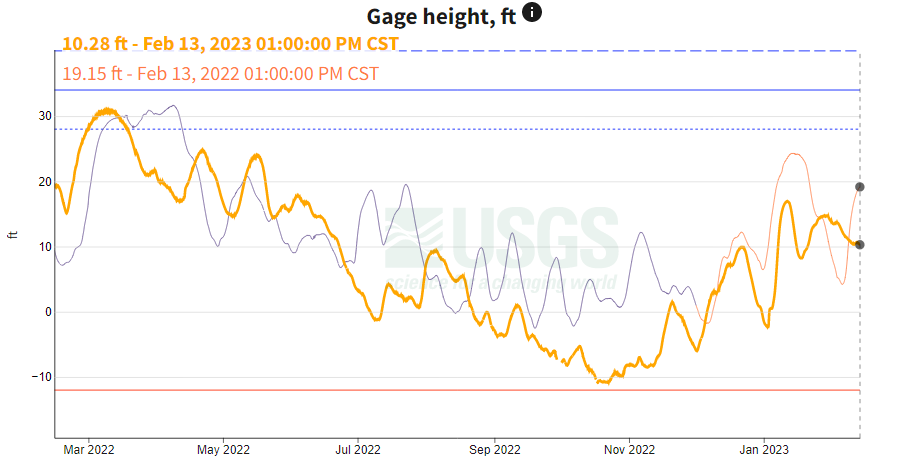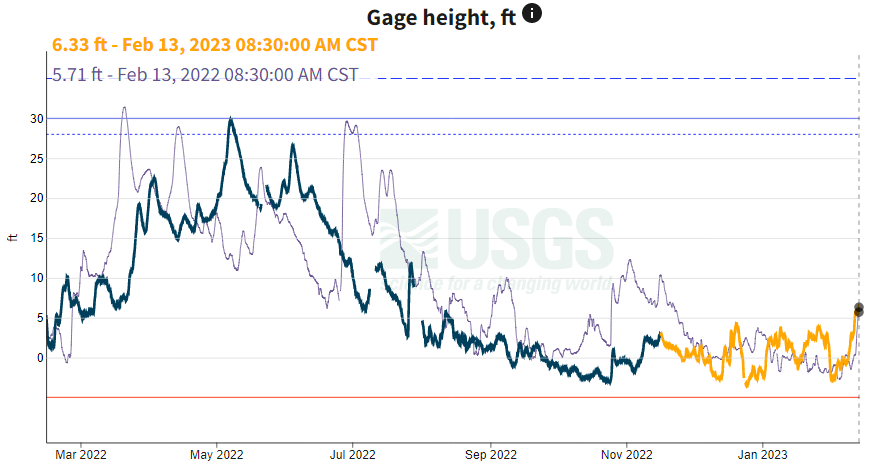
(Photo: Joclyn Bushman/Iowa Soybean Association)
Reducing Mississippi barge traffic stress
February 16, 2023
By Mike Steenhoek, Executive Director of the Soy Transportation Coalition
Since much attention was understandably provided last fall to the historically low water conditions along the Mississippi River and elsewhere, I wanted to provide a quick update on the current situation. Fortunately, export terminals and barge operators are reporting a return to normalcy. This is particularly the case along the lower Mississippi River. Much improvement has occurred in the corridor between St. Louis and Cairo, Illinois, but we have had some recent barge loading restrictions due to lower water levels. Many river observers conclude that we will remain with tight water level margins in the St. Louis area until water flows increase from the Missouri River later this spring. This is obviously an issue we will continue to monitor. Overall, though, we are pleased to be in a better place than we were in the fall/early winter of 2022.
Below are a couple charts from the U.S. Geological Survey from Memphis and St. Louis that compare current water levels to the same date last year. As you can see, water levels – especially at Memphis – can fluctuate quite significantly over the course of a week. Also included below are water levels over the past couple years. You will notice how water levels in early 2020 were considerably higher vs. the past three years. As you will recall, 2019 was a wet year – especially in the spring.
Memphis

Source: U.S. Geological Survey
For additional comparison, on February 13, 2021, the river gauge reading was 8.95 ft. On February 13, 2020, the river gauge reading was 29.03 ft.
- Lowest gage reading in 2022: -10.79 ft. (October 22nd, 2022)
- Highest gage reading in 2022: 30.71 ft. (March 9th, 2022)
- Action stage (the stage at which a rising water level will begin to trigger mitigation measures by the authority in charge): 28 ft.
- Minor flood stage: 34 ft.
- Major flood stage: 46 ft.
- Minimum operating limit: -12 ft.
St. Louis

Source: U.S. Geological Survey
For additional comparison, on February 13, 2021, the river gauge reading was 2.61 ft. On February 13, 2020, the river gauge reading was 17.75 ft.
- Lowest gage reading in 2022: -3.53 ft. (December 25th, 2022)
- Highest gage reading in 2022: 29.61 ft. (May 7th, 2022)
- Action stage (the stage at which a rising water level will begin to trigger mitigation measures by the authority in charge): 28 ft.
- Minor flood stage: 35 ft.
- Major flood stage: 40 ft.
- Minimum operating limit: -4.97 ft.
We are observing more of a return to normal not only with river levels but also with barge freight rates. In the U.S. Department of Agriculture’s “Grain Transportation Report”, for the week ending on February 7th, 2023, the barge rate for a shipment originating in St. Louis was $18.55 per ton. This compares to $25.06 per ton for the week ending on February 8th, 2022. This amounts to a 26% decrease in barge rates over the past year. According to the “Grain Transportation Report”, rates reached their highest for the week ending on October 11th, 2022, when they hit $105.85 per ton (originating in St. Louis). This was obviously during the period in which river levels were acutely low.
No one notices a road until they encounter a pot hole. In 2022, we had numerous “pot holes” that impacted our multi-modal transportation system. From historically low water levels on the Mississippi River, to the potential of a railroad strike, to a rise in fuel costs, to labor shortages, to congestion at our ports…there were a number of challenges agriculture and other industries had to manage. It serves as a reminder that a well-functioning supply chain is not just about cost, speed, and reliability, it is also about resiliency. Resiliency is an area that must be increasingly emphasized in 2023. We look forward to continuing to advocate for such a system for America’s soybean farmers.
Back